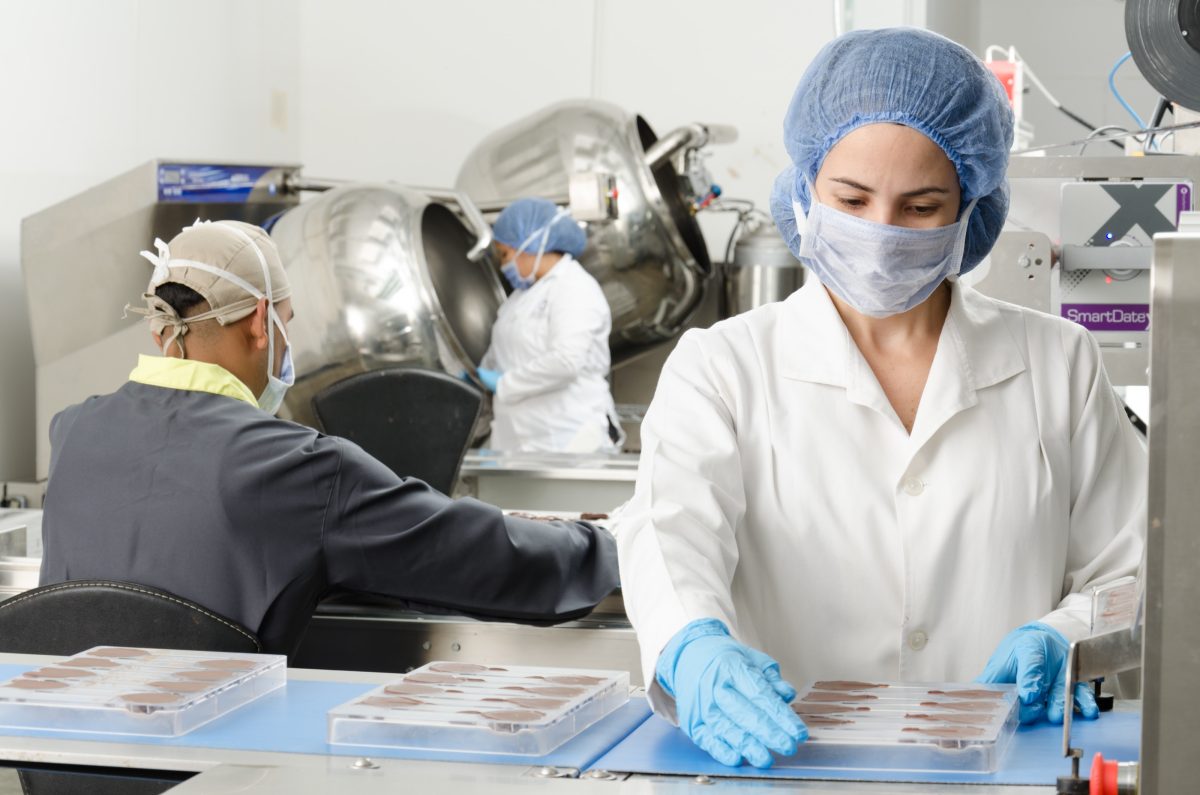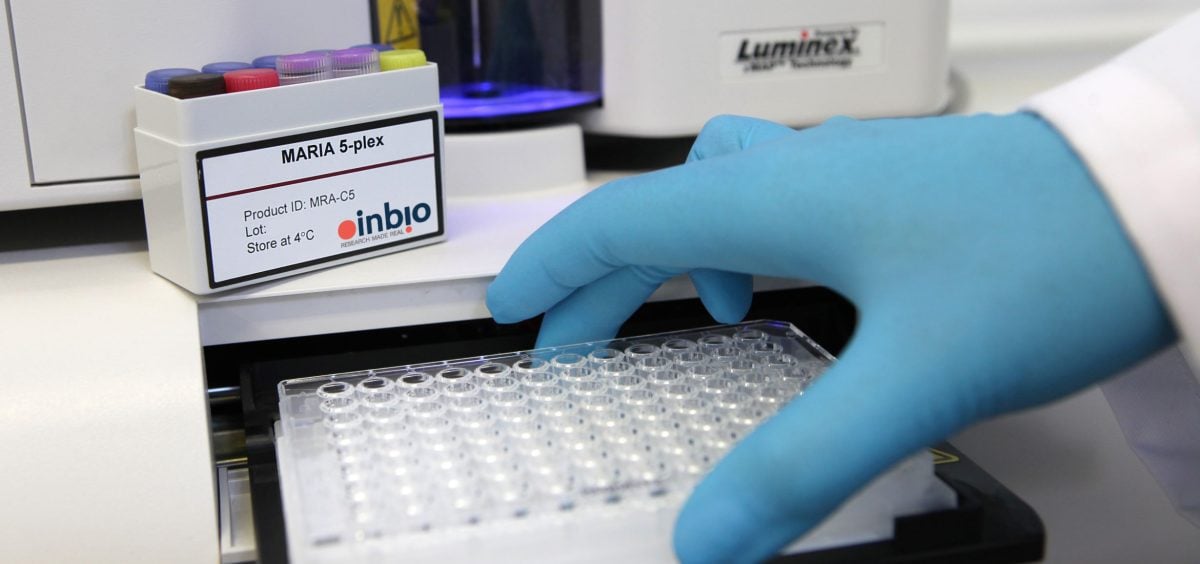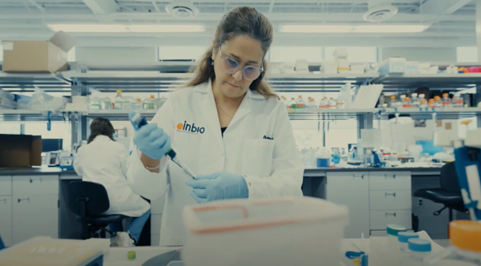
We recently had the opportunity to chat with Ross Yarham, Commercial Manager at InBio, an allergen research company specialising in manufacturing highly purified proteins and immunoassays. Immunoassays are laboratory tests that detect and measure specific biomolecules such as proteins, hormones, or antibodies in a sample, leveraging the unique binding between antigens and antibodies.
Working alongside businesses to improve their allergen processes and being at the forefront of research in the field, Ross gave us valuable insights into some of the most significant allergen issues currently facing the industry and an in-depth look at how InBio operates.
You worked previously for the FSA as their Senior Allergen Risk Assessor and as the head of the Food Allergy and Intolerance Research Programme. How do you feel those roles have informed and bolstered your position at InBio?
My role at the FSA had two main parts to it. One side was very regulatory and focused on incident management and risk assessment. I worked directly with FSA’s incidence team, food businesses and local authorities while developing the FSA’s quantitative risk assessment approach. The other part was my research role with the active ‘FAIR’ research program, such as setting up projects and scientific studies to help address gaps in knowledge of food allergies and intolerances, including mechanical work and analytical projects and psychological quality of life studies with our social sciences team. As a result, we gained a broad understanding of many different aspects of food allergies, not just risk assessment.
With all these different aspects comes a lot of research, working with diverse stakeholders, and getting exposure to views from various people from communities, local authorities, businesses, and charities. In my role at InBio, I am equipped with tools and analytical perspectives while understanding multiple points of view and what questions I might be getting from other groups.
When dealing with food safety professionals within businesses, what are their biggest allergen-related challenges?
It’s hard to pick one thing as it depends on the type of business and the nature of their supply chain. I’d say it’s mostly the availability of accurate allergen data, including ingredient level information and unintentional cross-contamination level information. This information isn’t always available or doesn’t always pass through the chain correctly onto product labels or displayed information when it reaches the consumer. Many of us will have seen this issue raised in some high-profile cases.
For cross-contamination assessments quite often, this process is very much qualitative, but I believe there should be a robust qualitative and quantitative approach to the risk assessment of cross-contamination.
What is the most significant negative impact on businesses when this goes wrong?
When incorrect allergen information on product labelling occurs, you need to have a high level of traceability to find out what and why it’s gone wrong and how to fix the issue so it doesn’t happen again.
In terms of business impact, this could be huge, as depending on the scale of their distribution chain and where this product has gone, such as if it’s on store shelves or in people’s homes, the cost (monetary & reputationally) of recalls can be substantial.
What size of businesses do you tend to work with, and how does the size impact the type of support you provide?
We work with many business types and sizes operating in different areas, focusing on more than just production or the supply chain. Most of our work until now has been to provide analytical reagents, tools and lab services to help standardise allergen diagnostics, treatments, and, more recently, immunotherapies. We’re very much operating in a pharmaceutical-type space to help ensure that products are highly standardised.
By taking the precision tools we’ve developed and applying them to the food industry, we can help fill some of the vital analytical gaps we’ve identified in this sector. Part of my role at InBio is to do just that. We have extensive experience, products, and services that we can tailor to each customer’s approach. We can adapt to our customer’s business size, their needs, and what issues they’re looking to address.
So whether they’re an SME or a large multinational organisation, there’s something you can do for them at any level.
That’s right, and that can range from supplying immunoassays or quality control materials if they’re doing their own analysis to more in-depth contract research. Just as some examples, we can conduct contract research that looks at the efficacy of cleaning approaches such as looking at a new solution for specific allergens on certain surfaces; conduct matrix (food) specific extraction assessments to improve confidence in analytical results; and even develop whole new immunoassays for key allergens of importance. We’ve already done a lot of this type of work for customers in-house at our labs in the UK and US.

Immunoassays are laboratory tests that detect and measure specific biomolecules such as proteins, hormones, or antibodies in a sample, leveraging the unique binding between antigens and antibodies. These techniques include methods like ELISA & Western Blot.
What type of customers are you working with, and how do they utilise these analytical tools?
We do work with a range of customers at different levels. The simplest level is that we offer an analysis service of various sample types, and we will tailor the extraction and the analysis we conduct depending on what that sample is. We also sell our laboratory reagents, so our immunoassay kits, quality control materials, allergens, and sometimes even just the antibodies can be sent to third-party testing labs. These labs sometimes have the specific accreditations to conduct analysis for regulatory compliance purposes, depending on their client’s needs. Many food businesses can also utilise our assays to perform their own in-house analysis if they have the correct capabilities.
We also have a lot of work with cleaning and consumer product companies. This is very much contract and R&D type testing, for example, to help them develop formulations of cleaning products that are effective against different types of allergens, not just in the food industry but also for indoor allergens. Some might not think these are relevant for the food industry, but they can be.
The other side is working for immunotherapy and allergen manufacturing companies. We work with these businesses to help standardise their testing materials, and as these are clinical treatments, there’s a much higher level of regulation that goes into them. As a result, they need to know the potency of these products, the allergen content, and that they’re also at consistent levels.
We also work with many academic and research institutes that use our allergens and antibodies as tools for their research.
What exactly are reagents?
In its core meaning, it is essentially a compound, a protein or something that starts and is involved in a chemical reaction. For us, these are allergens and antibodies. So, in combination with other compounds we use, we create our immunoassays that can be used to quantify the presence and concentrations of different allergens in samples.
What is the main difference between what InBio and LiberEat do?
Here at InBio, we do the physical testing of samples, such as laboratory analysis and results reporting. Our role with the food industry is to take these physical samples, run the analysis, and provide reports and data that the company can then use to inform them of control processes and mitigations they may need to put in place, as well as labelling decisions depending on the level of contamination.
On the other hand, LiberEat Allergen Error Detection Technology deals with all the data from ingredients, suppliers, and raw materials. It ensures everything gets communicated and put on the product label or menu correctly to protect the food business and consumers from allergen risk.
Let’s talk a little bit about food manufacturers and Food Allergy Research. How does InBio service those two sectors?

In terms of food manufacturers, we have our immunoassay platforms that have two main setups. One is the more straightforward ELISA 2.0 format, a single allergen test that somebody can run in two hours. It does require a laboratory of some kind, but nothing too complex in terms of machinery. It needs quite the common plate absorbance readers you find in most labs.
The other option is that our MARIA multiplex kits can be used if a food business, regulatory authority, or third-party testing lab needs to run for multiple allergens simultaneously. Think of it like ELISA, but the antibodies are bound to beads that are free in solution, so we can add lots of different beads sets targeting different allergens to that solution. They use similar reagents to our ELISA 2.0 system but can make it much more cost-effective when aiming to analyse multiple allergens. It’s also fully customisable (pick which allergens you are looking for), so it can be used as a powerful screening tool if you’re looking at switching suppliers and want to validate the information they’re giving you.
As for Food Allergy Research, that’s more of the academic side of things. For example, academics use our allergens or antibodies in various mechanistic studies where they’re trying to discover why some people develop allergic reactions and why proteins are either allergenic or not allergenic. It’s basic research through to cellular-based assays, for example.
How do InBio’s assays differ from currently available total protein assays, and why is that important?
Our assays are allergen-specific, so they’ve been generated using monoclonal antibodies and purified allergens as a source to develop them. This greatly reduces the risk of cross-reactivity, so we can more accurately report the content of relevant allergens in foods. It’s not always the case, but sometimes the antibodies and tests may not detect the relevant proteins within that food matrix so that you may get false positive results.
Our unique approach of purifying allergens and using these to create antibodies means we can develop these protein-based methods for complex allergenic foods, like some that may not have had protein-based methods before. For example, we’ve developed the first quantitative immunoassay for a major celery allergen. Previously, no protein-based or truly quantitative method was available for celery, which essentially made quantitative risk assessment impossible. We’re continuing to try to plug these gaps in critical allergen analysis.
We see a lot of rapid developments in food safety technology at the moment. How does InBio stay ahead regarding research methods and equipment to detect allergens?
Most of us here at InBio are scientists, so research into continued development, improving things, and looking at what’s new is pretty much at our core. We’re involved in many international research & analytical communities and attend conferences and events where many initiatives, new data, and research are shared. We play an active part in driving a lot of innovation in this space while also learning and taking on board new methods and cutting-edge equipment that we can better use to serve our customers, improve our products, and better characterise allergens.
Globalisation is making the food supply chain more complex and changing the global economy due to current events. How does this affect InBio and how do you adapt to cater to that worldwide market?
It’s becoming much more complex for sure. However, we’ve always operated globally, so we’ve adapted to changing trends in allergen analysis and customer profiles and kept up to date with the latest research & developments to advance our portfolio and lead developments in this space.
We are always led by scientific developments and our customers’ needs as everyone’s slightly different. Our analytical targets apply to a broad range of relevant food allergens on different regulatory lists. Our MARIA For Foods assay, for example, has 17 allergens on that plex that we can customise, which covers a vast range of internationally regulated allergens. We also have an active R&D pipeline looking at emerging food allergens that are becoming more important globally or in certain regions. Watch out for pea allergens!

Where do you see allergen containments most present in food and why?

Many key risks exist in different parts of the food supply chain and production. One example that stands out to me from my previous and current experiences would be raw ingredients and food products that don’t contain milk but are manufactured in areas where milk is present. We frequently see this because milk is widely used, has a high protein content and can be present in various forms, such as liquid, bulk solid, powder, and even steamed; the latter two can be easily aerosolised so it can spread easily.
When thinking about food production and retail specifically, what primarily causes allergen-related food recalls or errors in communication with consumers?
Drawing back on my allergen risk assessor role and experience at the FSA, I’d say most withdrawals and recalls were due to labelling issues on the packaging – this ranged from regulatory non-compliant labelling such as lacking correct emphasis of allergenic ingredients to more serious labelling issues such as completely omitted allergenic ingredient declarations or even the entirely wrong packaging for a food!
These errors seemed to arise due to food businesses using incorrect raw ingredient information, labelling checks not being done correctly, and typically some human error, such as updates not being carried out when there’s a change in ingredient or supplier. There were also several unintentional allergen cross-contamination incidents, mainly due to milk!
How do food business operators work with InBio to test their products and food items, and what does this process entail?
A lot of our work with food businesses currently focuses on new product development or assessment of new ingredient supplies to screen for unintentional allergen presences, which are then checked back against specifications and information given by the supplier. This type of assessment and validation is essential to ensure accurate labelling downstream, so usually, we discuss our customer’s needs, and then they’ll submit samples to one of our labs in the US or the UK, containing relevant information such as what food/matrix type it is and what allergens they want it tested for. These are then extracted and analysed, and we’ll report the results to them with relevant information.
The extraction point is quite an essential part of allergen analysis and this is why we ask for detailed information on the food sample type, as the extraction needs to be optimised as it will affect the results if not done correctly.
Let’s talk about ‘Free From’ products. How do you see InBio as a great partner specifically for these businesses?
Due to the nature of our immunoassays and their sensitivity & specificity, we’re uniquely suited to help the ‘free from’ product businesses to ensure the absence of key clinically relevant allergens in their foods and on their production lines. They can utilise our assays through a third-party testing lab or send samples directly to us. This can be to test their ingredients, production lines, and the final product.
It’s a fast-growing market that will need more and more support from companies like InBio to test their items, and they’ll need LiberEat’s support to ensure their data is correct.
Definitely, a trend I saw in my role at the FSA is that companies were entering the ‘free-from’ market because they saw an opportunity but did not necessarily understand what it meant from a safety perspective. From a food safety perspective, a ‘free from’ claim is an absolute claim, not just a marketing statement. You are saying that your food is safe to consume for those most at risk, so it’s a big food safety issue if you get it wrong.
Which of the UK’s 14 Major allergens or the US’s nine major allergens cause businesses the most stress in your experience, and do you think any should be removed or added?
It comes back to milk again. It’s one of the more common allergens I see and seems more and more of an issue. While at the FSA, I commissioned a project that looked at hospital admission rates and rates of fatal anaphylaxis cases, and milk is the cause of most fatalities in the younger population. That shifts to peanuts and tree nuts in the adult population, but milk needs more attention.
It’s hard to say too much about the other UK 14 allergens and other regulatory allergens as there’s a lack of prevalence and relevant data supporting some of those, so more data is required to inform decisions of adding or removing as well as considerations around the broader impacts of such changes. Regardless, I think all food allergies should be treated with utmost seriousness, irrespective of whether they’re on the list. Everyone should be entitled to safe food.
How do you see the future of food allergen safety, and what do you think will be significant changes or milestones in that?
I think we’re going to see a lot of development in various areas. Still, I think the biggest milestone will be the implementation of standardised quantitative risk assessment approaches and defined regulatory thresholds that people can compare and perform those risk assessments to.
It’s something I’ve worked on a lot during my time at the FSA and in an advisory capacity in my current role, where I remain part of a few different networks where this is a big topic. We’ve done a lot of work to support that advancement.
This regulatory setting of threshold levels is a vital part of food allergen safety that’s currently missing, and we have excellent data and information to inform such regulatory action and legislation. Through organisations such as the International Life Science Institute (ILSI), we’ve provided tools and frameworks for businesses to analyse all different scenarios and stages and for authorities to follow.
There’s now a comprehensive review and position from a World Health Organisation/Food and Agriculture Organisation expert group, which has spoken about this internationally and recommended that certain levels be considered. Everything is there to hopefully introduce harmonised regulatory levels on an international scale to avoid the increasing disparity in international regulatory approaches that seems to be occurring.
Where do food businesses working with InBio see significant changes and improvements?
Food businesses can improve their confidence and the allergen content of their raw ingredients, new supplier material assessments, the effectiveness of allergen cleaning and manufacturing equipment on the production lines, and verify all of their control processes by analysing the final product samples. So it’s the whole chain!
How does InBio raise awareness and educate businesses or consumers about the importance of food allergens and safety?
We have over 25 years of contributing significantly to the allergy scientific field, being involved in scientific publications, talks, and events around allergies generally. We also support vital charities worldwide, particularly in the UK, with charities such as Allergy UK and Anaphylaxis UK, which we’ve been avid corporate sponsors of for several years. We also run frequent webinar series on all sorts of topics in the allergy space, such as the analytical mechanistic work we’ve conducted.
You can check these out on the InBio website and on the InBio YouTube Channel.
On a personal note, you have a great passion for allergen safety and a varied career so far in different elements of it. What drives your passion for ensuring allergen safety, and what personal experiences or stories shaped that journey?
I’m lucky enough not to have experienced a severe allergic reaction of a loved one firsthand. I have, however, had an anaphylactic reaction when I was quite young due to an unknown source that’s still undiagnosed. I haven’t thought much about it, but I guess it has helped shape my interest in the area and helped prevent others from experiencing similar incidents. The conversations and exposure I’ve had over the years to different stories and experiences of others with food allergies or families of those with them have just helped solidify the importance of this topic for me personally.
So far, my career has focused on allergens and risk assessment and generating evidence to inform better food allergen safety processes. I plan to do this for many more years to come.
Thanks for talking with us, Ross! If you’re interested in more interviews with industry professionals, we’ve previously spoken with Lucinda Bruce-Gardyne, founder of Genius Foods, and Caroline Benjamin, founder of Food Allergy Aware and co-founder of Hospitality Allergen Support UK. There are many more to come, so be sure to follow us on LinkedIn to be informed to stay updated.
You can learn more about LiberEat Allergen Error Detection Technology and speak to our team here.
LiberEat - Allergen Error Detection Software
Food allergen rules and regulations continue to change and evolve. Food businesses in production, hospitality, catering, and retail must be vigilant when working with ingredients, products, and dishes containing allergens and exercise due diligence when providing ingredient and allergen information to consumers. Successful allergen management is a big part of Food Safety professionals creating a culture of care and excellence within their teams.
LiberEat offers a second line of defence for food businesses by detecting errors, allergens, and other harmful ingredients with our proprietary Allergen Detection Software. Food businesses can apply this technology directly to identify errors in allergen communications, preventing the risk of injury to consumers. Contact us today to learn more about how we can support your existing food safety processes.
LiberEat works closely with food businesses to ensure consumers are safe and healthy when consuming your produce.

